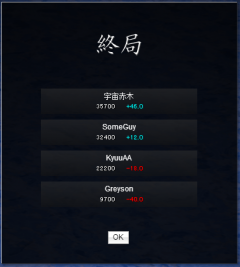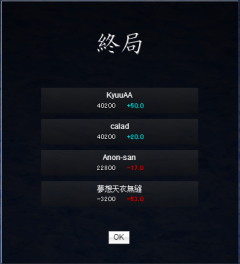Oka and uma: Difference between revisions
m (→Shortcut) |
|||
| Line 24: | Line 24: | ||
[[Image:PlusMinus.png|thumb|240px|right|End game results with raw scores and uma scores]] | [[Image:PlusMinus.png|thumb|240px|right|End game results with raw scores and uma scores]] | ||
This short cut only applies to the distribution of (+20/+10/-10/-20). Using the procedure above, suppose all players unrealistically finish with 25,000 points each. The target points is 30,000 as standard. | This short cut only applies to the distribution of (+20/+10/-10/-20). Using the procedure above, suppose all players unrealistically finish with 25,000 points each. The target points is 30,000 as standard. | ||
{{uma compare| | |||
<!--player scores--> | |||
|score1 = 25000 | |||
|score2 = 25000 | |||
|scpre3 = 25000 | |||
|score4 = 25000 | |||
<!--uma settings--> | |||
|uma1 = 20 | |||
|uma2 = 10 | |||
|uma3 = -10 | |||
|uma4 = -20 | |||
|startpts = 25000 | |||
|targetpts = 30000 | |||
}} | |||
As a shortcut, the adjustment can use the scores in the first column. Then the scores can be divided by 1000 and rounded. Finally, the values in the last column can be used to adjust for the final scores. Once again, this only works with the regular (+20/+10/-10/-20) uma. | As a shortcut, the adjustment can use the scores in the first column. Then the scores can be divided by 1000 and rounded. Finally, the values in the last column can be used to adjust for the final scores. Once again, this only works with the regular (+20/+10/-10/-20) uma. | ||
| Line 29: | Line 44: | ||
Just to show, the values in the image to the right are used: | Just to show, the values in the image to the right are used: | ||
{| | {{uma compare| | ||
! | <!--player scores--> | ||
|score1 = 35700 | |||
|score2 = 32400 | |||
|scpre3 = 22000 | |||
| 35700| | |score4 = 9700 | ||
<!--uma settings--> | |||
|uma1 = 20 | |||
| | |uma2 = 10 | ||
|uma3 = -10 | |||
| | |uma4 = -20 | ||
| | |startpts = 25000 | ||
|targetpts = 30000 | |||
}} | |||
As a note, the values on the right hand column did not change as the corresponding raw scores differed. So, to quickly determine the end score, it is simply the rounding of the player's score divided by 1000. Then the values in the last column is applied according to placement. | |||
===With different oka and uma=== | ===With different oka and uma=== | ||
Revision as of 03:10, 18 January 2015
At the end of the game, the raw scores are converted into an "end game score". This is most commonly referred as the plus-minus (+/-) score. The four end game scores are always set up to sum with zero. However, due to rounding errors, it is possible for the scores to equal to 1 or -1. In this case, the leader's or that of last place end game score is adjusted to ensure a zero sum.
Oka and uma
The oka 「オカ」 is the point difference between the start score and the target score; and then it is multiplied by the number of players. In general, this can be viewed as the "ante". Typically, the start score and target score are 25,000 pts and 30,000 pts respectively. So, in this case the oka is 5,000 x 4. At the end of the game, the oka is awarded to the winning player.
The uma 「ウマ」 is the set point spread applied to the players at the end of the game. The typical point spread uses the format of (+A/+B/-B/-A), where A > B. Of course, the point spread does not necessarily have to follow that pattern, by which the spread does not have to be symmetric. In general, the point spread can be set to any value as long as the four numbers add up to zero. Point modifications may be used either to ease the conditions or increase the difficulty, particularly for tournament settings.
Procedure
The end game score is calculated as follows:
- Raw are taken at the end of the game, naturally ordered by the final point values.
- Note the start score and target score point difference, find the oka.
- Subtract the target score from the final point values.
- Add the oka to the winner.
- Divide by 1,000.
- Round to the nearest integer. If the division result produces a digit of 0.5, then the number is rounded down.
- Apply the uma spread, if any.
- If the sum of all four does not equal to zero, then the winner's score is adjusted to produce a zero sum.
Due to rounding, the final values may not add up to zero. Therefore, it may become necessary to alter the winner's score. Usually, the difference is only +/- 1.
End score = (((Raw points + Oka - (Target - Start))/1000) + Uma
Shortcut

This short cut only applies to the distribution of (+20/+10/-10/-20). Using the procedure above, suppose all players unrealistically finish with 25,000 points each. The target points is 30,000 as standard.
| Raw score conversion | Score comparison: Uma 「20 / 10 / -10 / -20」 | ||||
|---|---|---|---|---|---|
| Raw scores | Rounded to nearest 1000 | Div by 1000 (A) | End score (B) | End score diff (B - A) | |
| 25000 | 25000 | 25 | 35 | 10 | |
| 25000 | 25000 | 25 | 5 | -20 | |
| 30000 | 25000 | 25 | -15 | -40 | |
| 25000 | 25000 | 25 | -25 | -50 | |
As a shortcut, the adjustment can use the scores in the first column. Then the scores can be divided by 1000 and rounded. Finally, the values in the last column can be used to adjust for the final scores. Once again, this only works with the regular (+20/+10/-10/-20) uma.
Just to show, the values in the image to the right are used:
| Raw score conversion | Score comparison: Uma 「20 / 10 / -10 / -20」 | ||||
|---|---|---|---|---|---|
| Raw scores | Rounded to nearest 1000 | Div by 1000 (A) | End score (B) | End score diff (B - A) | |
| 35700 | 36000 | 36 | 46 | 10 | |
| 32400 | 32000 | 32 | 12 | -20 | |
| 30000 | 25000 | 25 | -15 | -40 | |
| 9700 | 10000 | 10 | -40 | -50 | |
As a note, the values on the right hand column did not change as the corresponding raw scores differed. So, to quickly determine the end score, it is simply the rounding of the player's score divided by 1000. Then the values in the last column is applied according to placement.
With different oka and uma
Naturally, with different oka and uma settings, the numbers will work themselves out differently than the (+20/+10/-10/-20) set up.
Tie-breaker

In the event of tied scores at the end of a game, then the tie-breaker based on the initial wind seating (or the first hand) is applied. The player closest to the dealer position takes the higher position. Afterwards, the final score procedure takes into effect. Even with tied scores, the player in the lower position will receive a lower uma score.
External links
- Oka and uma in Japanese Wikipedia